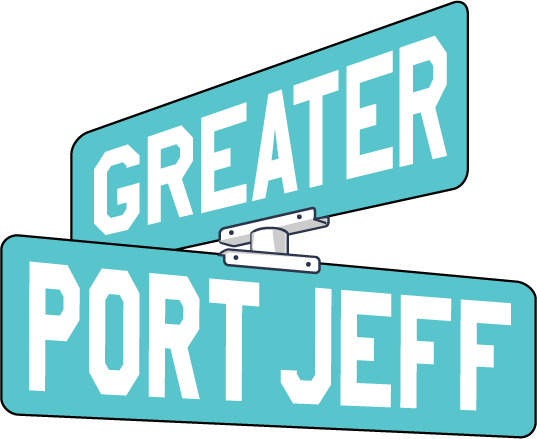
Click here for Greater Long Island newsletters. Click here to download the iPhone app.
After fits and starts, legally required studies, a rebranding, and countless hours of discussion, presentations, and negotiations, it seems as if the long-awaited revitalization of Upper Port Jefferson might finally begin in earnest.
There are two new development projects being proposed for the east side of Route 112 in the distressed neighborhood (scroll down to learn more).
The current rebirth efforts were launched almost 10 years ago as “Upper Port Jefferson Revitalization,” and have since been re-christened with the pop song-influenced title of “The Uptown Funk.”
The development of The Hills — a 70+ rental apartment complex on the corner of Texaco Avenue and Linden Place — by the Port Jefferson-based Gitto Group represented one of the first big wins in reimagining the neighborhood as a transit-oriented development area, friendly to commuters and attractive to young professionals.
A renovation of the Long Island Rail Road station parking lot added another piece of the puzzle to make Upper Port Jefferson a more inviting gateway to the village.
That project included upgrades to the station and parking lot funded by the MTA, complete with a new sculpture on the grounds celebrating the ship-building heritage of the village.
A combination of New York State and Suffolk County grants announced by the village helped offset costs to renovate the Texaco Avenue parking lot on the west side of Route 112 and will go towards building a new roadway to the LIRR station to be called Station Street.
The idea of the plan is to transform a long-blighted, crime-plagued area into a place that would be welcoming to visitors and attractive to people who want to live and work on Long Island but desire the convenience of close transportation and the proximity to the already beautiful downtown Port Jefferson.
Once again, the model of urban renewal is the village of Patchogue and its economic renaissance.
Mayor Margot Garant pointed to that South Shore village’s comeback, and the success of affordable housing complexes like ArtSpace as an example.
But she noted, such a major makeover takes time.
“Rome was not built in a day,” she said about the Upper Port Jefferson revitalization plan, in a video interview on PortJeff.com. “It’s a heavy lift.”
In a phone call with GreaterPortJeff, Garant outlined some of the requirements of New York State — before the plan could be enacted.
“It’s a step-by-step process,” she said.
Over the last few years, the village had to submit multiple studies and plans including a master plan, a revitalization plan, a blight study, and an urban renewal plan.
Once approved, they shaped the vision of what the neighborhood could become as developers move in to propose projects. And the village can enact eminent domain to ensure owners sell vacant, blighted buildings that are holding up renewal efforts.
The mayor said that although the village can’t actually do the rebuilding itself, through zoning guidelines, code, and other methods, it can influence the changes they seek.
“It was an important part of the planning to get to this point,” she said.
The properties just north of the train station on either side of Route 112 have been grouped together and further split into four quadrants, targeted for redevelopment, according to Garant. (See illustration below.)
the final pieces
Two projects are being proposed for Upper Port to go along with The Hills, parking lot enhancements, and the upgraded LIRR station.
The hope is to add two large pieces that fit into the puzzle, presenting a clearer picture of what Uptown Funk might look like in the end.
North of the Long Island Rail Road, where the infamous Badabing building stands (now called Bahia, pictured above), a venture is in the works to develop a mixed-use building with a 100 percent affordable housing component.
This is something the mayor says is needed, especially in transit-oriented development.
“Everybody is building market rate housing [in Port Jefferson],” she said. “I’m a huge proponent of affordable housing.”
Affordable housing, according to the mayor, will help empty-nesters who sell their homes stay in the area, and provide housing opportunities for young professionals and students. Both of these demographics could benefit from the close proximity of the LIRR, she said.
According to a recently released study by the Long Island Index, the development of transit-oriented multifamily housing is an important part of Long Island’s future.
The report says that “Long Island is lagging other parts of the New York region and unaffordable for too many” with more people paying far above the standard of 30 percent of total income in housing costs.
Unaffordability is driving people off Long Island and villages around the region are trying to entice builders to provide more affordable housing options to retain both younger and older people alike.
“It’s refreshing to see that the redevelopment of the upper Port Jeff area finally gaining traction, especially since the area has been economically stagnant for far too long,” said Richard Murdocco, a public policy and planning expert who teaches in the public policy graduate program at Stony Brook University.
Murdocco imagines a balanced approach to the process.
“Smart development near the LIRR can underpin future sustainable growth,” he said.
Garant estimated that up to 30 percent of housing uptown will be affordable.
If the project is approved, it will consist of a mix of retail and residential space, adjacent to the LIRR station. The Station Street roadway will be built to better connect that housing to transportation.
The second planned project is called “Walnut Hills,” according to Garant. That’s planned for the area bordered by Perry Street to the south, Walnut Street to the east and Route 112 to the west. The quadrant stops at Tara Inn to the north. The site includes the old diner that was torn down three years ago.
Rob Gitto from The Gitto Group is developing the project as a joint venture.
Gitto, who spoke with GreaterPortJeff by phone, envisions a mixed-use building with retail on the ground floor and residential above, but could not yet comment on the square footage or the number of units.
“We’re working on it,” he said. “But we’re very far off.”
He said that the apartments would be market rent units.
The Hills, according to Gitto, was a success for his company and the village. He’d like to see that replicated for every project uptown.
According to Gitto the 74-room apartment building was pre-leased before they even opened up the first phase — and there is a still waiting list for units.
“We were surprised how well we did with the project,” he said.
And, renters sometimes become long-term village residents, according to Gitto. He cited one couple who moved into the area from Queens to work at Stony Brook Hospital and decided to put down roots and buy a house in Port Jefferson.
Gitto, who was born in St. Charles hospital and grew up in the village, said that although he is running a business, profit is not the company’s only goal.
“We are adding people to the community who fall in love with the area and they end up making this their home,” he said. “The plus side is bringing people to the area.”
Revitalization and renewal of Upper Port makes sense to Gitto, and he wants to be a part of it.
“With the success with the other property, we are very interested in doing more in the area.”
He credits the high quality of the apartments his company built at the Hills as well as other amenities like the Qwik Rides program that enables people uptown to easily enjoy everything downport has to offer. All while still being close to public transportation.
While Murdocco applauds the new efforts, he cautions about what he calls a “build-it and they will come mentality” when developing transit-oriented developments.
“Policymakers should be realistic with their ambitions,” he said.
He thinks that Port Jefferson might have the right idea in the wrong place.
“While the LIRR is within walking distance of these projects, local usage isn’t quite at the levels we’ve seen in places further west like Mineola – and may never be,” he said.
There is already interest in properties in the two quadrants on the west side of Route 112 with developers eyeing similar complexes.
The LIRR had been exploring options to electrify the Port Jefferson line, and use the Lawrence Aviation site as a rail yard. This might help create more demand for housing around the LIRR station, both north and south of the tracks.
An MTA video on YouTube announced that Port Jefferson electrification plans are underway.
Plans for the electrification of the Port Jefferson branch goes back more than 30 years, when in 1985 the plug was pulled after the MTA announced funding shortfalls.
Garant is still hopeful that all the efforts the village has put into revitalization are now coming to fruition with these two new projects.
“We have some tough challenges uptown but we have some interest now.”
the quadrants
























